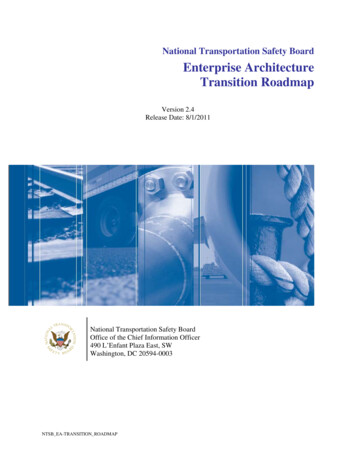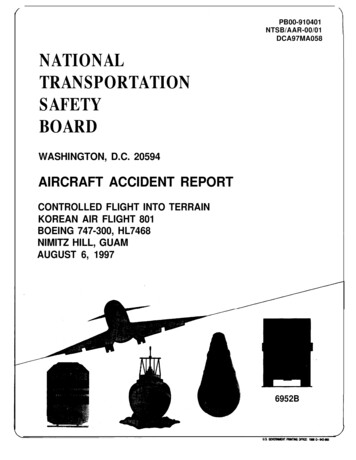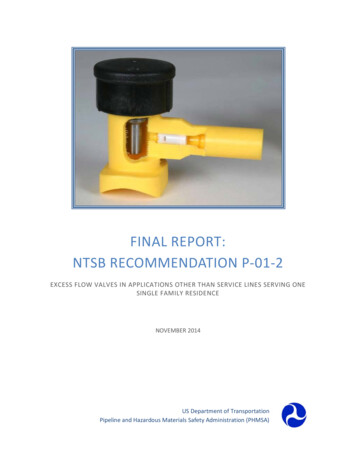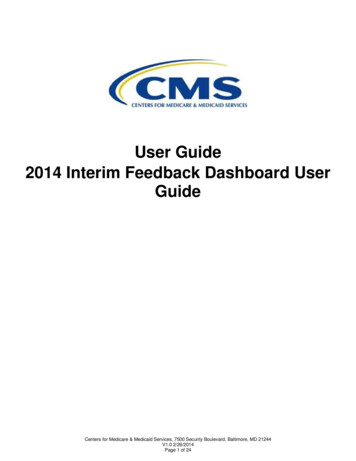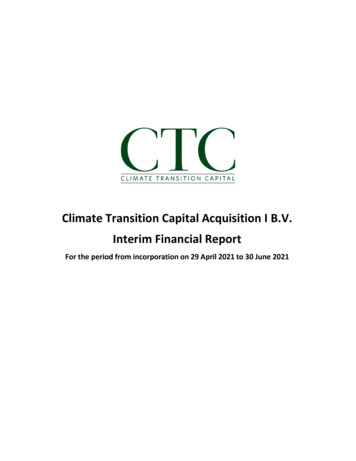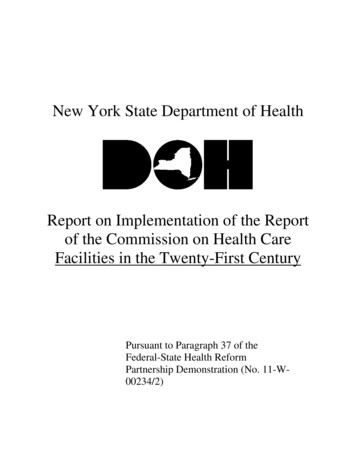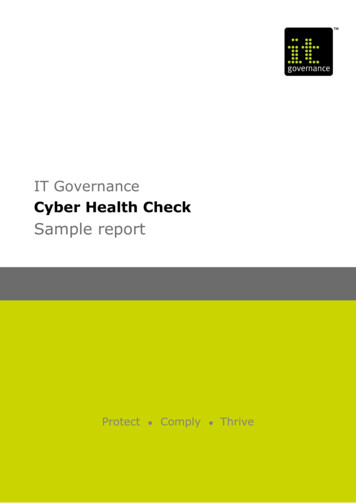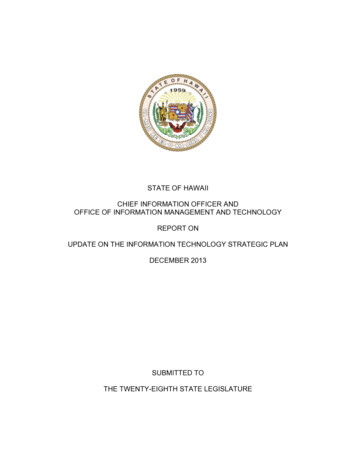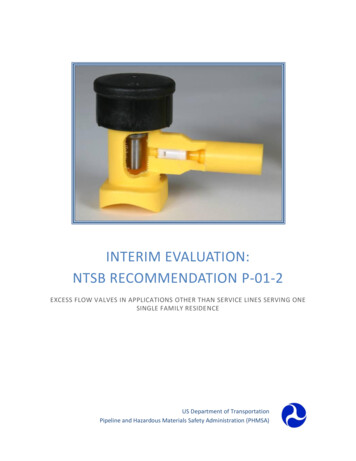
Transcription
INTERIM EVALUATION:NTSB RECOMMENDATION P-01-2EXCESS FLOW VALVES IN APPLICATIONS OTHER THAN SERVICE LINES SERVING ONESINGLE FAMILY RESIDENCEUS Department of TransportationPipeline and Hazardous Materials Safety Administration (PHMSA)
TABLE OF CONTENTS1. PURPOSE .12. BACKGROUND OF NTSB SAFETY RECOMMENDATIONS AND PHMSA ACTIONS TAKEN TO DATE.32.1 BACKGROUND OF THE SAFETY FUNCTION EFVS PERFORM . 32.2 NTSB SAFETY RECOMMENDATIONS CONCERNING EFVS . 32.3 PHMSA ACTIONS IN RESPONSES TO NTSB RECOMMENDATIONS . 52.3.1 PHMSA Actions Related to Role of EFVs in Reduction of the Failure Consequences . 52.3.2 PHMSA Actions Related to Reducing the Likelihood of Failure of Services . 72.3.3 PHMSA Evaluation of Data Related to Incidents on Services . 103. STAKEHOLDER VIEWS . 193.1 STAKEHOLDER MEETINGS . 193.1.1 National Transportation Safety Board (NTSB) . 193.1.2 National Association of Regulatory Utility Commissioners (NARUC) . 193.1.3 National Association of Pipeline Safety Representatives (NAPSR) . 203.1.4 International Association of Fire Chiefs (IAFC). 213.1.5 National Association of State Fire Marshals (NASFM) . 223.1.6 American Gas Association (AGA), Representing Distribution Operators . 233.1.7 Pipeline Safety Trust (PST) . 243.1.8 EFV Manufacturers . 253.1.9 EPA Gas STAR program . 254. TECHNICAL STANDARDS AND GUIDANCE FOR EFVS . 265. U.S., STATE AND INTERNATIONAL REGULATIONS . 285.1 PHMSA – U.S. REGULATIONS . 285.2 STATE REGULATIONS . 295.3 INTERNATIONAL EFV REGULATIONS . 296. OPERATING EXPERIENCE WITH EFVS . 316.1 DOMESTIC EXPERIENCE - NATIONAL REGULATORY RESEARCH INSTITUTE (NRRI) SURVEY RESULTS. 316.2 DOMESTIC EXPERIENCE WITH USE OF EFVS IN NON-SFR SERVICE . 316.2.1 NiSource . 326.2.2 Bay State Gas . 326.2.3 Columbia Gas of Maryland . 326.2.4 NW Natural . 326.2.5 Kansas Gas Service (KGS) . 336.3 INTERNATIONAL EXPERIENCE . 337. EFV MANUFACTURERS . 358. CHARACTERISTICS OF U.S. DISTRIBUTION SYSTEMS . 36
8.1 SERVICE LINE SIZE, MATERIAL, AND PRESSURE . 368.2 PERSPECTIVE ON EXCESS FLOW VALVE EFFECTIVENESS IN GAS DISTRIBUTION SYSTEM SERVICE LINES . 389. TECHNICAL CHALLENGES ASSOCIATED WITH USE OF EFVS IN NON-SFR SERVICE . 409.1 EFFECT OF CHANGING GAS USAGE PATTERNS ON SELECTION OF EFV SIZE . 409.2 SNAP LOADS. 409.3 BUSINESS-CRITICAL GAS SUPPLY APPLICATIONS . 409.4 SYSTEM CONFIGURATION . 419.5 PRESSURE RATINGS . 439.6 SIZE OF COMMERCIALLY AVAILABLE EFVS . 4310. ECONOMIC ANALYSIS CONSIDERATIONS . 4410.1 PREVIOUS BENEFIT-COST ANALYSIS FOR SINGLE FAMILY RESIDENCES. 4410.2 IDENTIFYING AND DEFINING THE TARGET PROBLEM AND CANDIDATE SOLUTION(S) . 4510.3 DEFINING THE SCOPE AND PARAMETERS OF THE ANALYSIS . 4610.3.1 Feasibility/Practicality . 4610.3.2 Categories of Services . 4710.4 DEFINING COST FACTORS . 4910.5 DEFINING BENEFIT FACTORS . 5010.5.1 Quantifying Expected Number of Incidents or Consequences Averted. 5010.6 AVAILABILITY OF DATA RELATED TO APPLICATION OF EFVS IN NON-SINGLE FAMILY RESIDENCE SERVICE . 5111. SUMMARY . 5311.1 KEY OBSERVATIONS . 5311.2 NEXT STEPS. 5311.2.1 Detailed Regulatory Analysis . 5311.2.2 Improve Technical Standards . 54APPENDIX A. NTSB INVESTIGATIONS OF DISTRIBUTION INCIDENTS . 55A.1 STUDIES AND SERVICE LINE INCIDENT REPORTS LEADING UP TO NTSB RECOMMENDATION P-01-02 . 55A.1.1 Special Study of Effects of Delay in Shutting Down Failed Pipeline Systems and Methods ofProviding Rapid Shutdown, December, 1970. (NTSB PSS-71-01). 55A.1.1.1 Hapeville, GA, May, 1968 . 56A.1.2.1 Reading, PA, January 8, 1968 . 56A.1.2 Lake City, MN, October, 1972 (NTSB PAR-73-01) . 56A.1.3 New York, New York, April, 1974 . 57A.1.4 National Transportation Safety Board Special Study . 57A.1.5 National Transportation Safety Board Special Study . 58A.1.6 Standardsville, VA, October, 1979 (NTSB-PAR-80-3) . 58A.1.7 Independence, KY, October, 1980 (NTSB-PAR-81-1). 59A.1.8 NTSB Special Study, Pipeline Excess Flow Valves, September 1981 (NTSB/PSS-81/01). . 60A.1.9 Burke, VA, October, 1982 . 62
A.1.10 Kansas Power and Light Company Gas Distribution System Incidents Accidents September 16,1988 to March 29, 1989 NTSB/PAR-90-03 . 62A.1.11 Santa Rosa, CA, December, 1991. . 63A.1.12 Allentown, PA, June, 1994 (PAR-96-01) . 64A.1.13 South Riding, VA, July, 1998 (PAR-01-01) . 65A.1.14 St. Cloud, MN, December, 1998 (PAR-00-01) . 65A.2 POST P-01-02 NTSB INCIDENT INVESTIGATIONS RELATED TO EFVS . 66A.2.1 Bridgeport, AL, January, 1999 (PAB-00-01) . 66A.2.2 Wilmington, DE, July, 2002 (PAB-04-01) . 66A.2.3 DuBois, PA, August, 2004 (PAB-06-01) . 66A.2.4 Bergenfield, NJ, December, 2005 (PAB-07-01) . 67A.2.5 Plum Borough, PA, March, 2008 (PAB-08-01) . 67APPENDIX B. REGULATORY RESPONSE TO NTSB RECOMMENDATIONS . 71APPENDIX C. SUMMARY OF EFVS AVAILABLE FROM MAJOR VENDORS . 75C.1 DOMESTIC VENDORS . 75C.1.1 UMAC. 75C.1.2 LYALL . 75C.1.3 DRESSER . 76C.1.4 ELSTER PERFECTION . 76APPENDIX D. GAS DISTRIBUTION SERVICE LINE DATA. 78D.1 U.S. SERVICE LINES BY MATERIAL AND LINE DIAMETER . 78D.2 SERVICE LINE INCIDENTS BY SYSTEM PRESSURE . 78
INTERIM EVALUATION: NTSB RECOMMENDATION P-01-21. PURPOSEThe National Transportation Safety Board (NTSB) advocates that Excess Flow Valves (EFV) are aneffective way to save lives and protect property and has long recommended their use. The NTSBposition is that when sized and installed properly, an EFV can offer additional assurance against the risksassociated with gas service line ruptures by instantaneously shutting off the flow of gas. Between 1971and 2001 NTSB issued more than ten recommendations that dealt with utilization of EFVs. The mostrecent NTSB proposal, Safety Recommendation P-01-2, advocated that the Pipeline and HazardousMaterials Safety Administration (PHMSA) “[r]equire that excess flow valves be installed in all new andrenewed gas service lines, regardless of a customer’s classification, when the operating conditions arecompatible with readily available valves.”The Pipeline Integrity, Protection, Enforcement, and Safety Act of 2006 (PIPES Act of 2006) mandatedthat PHMSA require operators of natural gas distribution systems install excess flow valves on new andrenewed service lines serving single family residences (SFR) that operate at or above 10 psig whentechnically feasible and commercially available. PHMSA codified this requirement in 49 CFR 192.383.The PIPES Act of 2006 did not mandate that EFVs be installed on service lines of branched single familyresidences, apartment buildings, other multi-residential dwellings, commercial properties or industrialfacilities, all of which are susceptible to the same risks caused by damaged gas lines serving single familyresidences. In response to NTSB Recommendation P-01-2, PHMSA is exploring issues surrounding, andalternatives to, the installation of EFVs on the classes of service that were not included in theCongressional mandate. PHMSA believes the recommendation needs to be evaluated, to avoid apotential final NTSB classification of this recommendation as “unacceptable”.Three applicable technical standards apply to the specification, testing and manufacture of EFVs fornatural gas service. The scope of these standards does not extend to the larger EFVs required for somehigh demand applications. However, EFVs are currently manufactured for use in service lines with flowrates greater than those required by single family residences. Additionally, the technical standards donot cover topics which directly impact the performance and reliability of EFVs such as installationconfiguration and methods, sizing and selection, or performance testing of EFVs after installation.The purpose of this report is to summarize current information on EFVs in order to: Respond to the NTSB safety recommendation with respect to applications other than servicelines serving one single family residence (above 10 psig).Build a foundation for an economic analysis.Consider the need for enhanced technical standards or guidelines.Suggest that any new technical standards include criteria for pressure drops across the EFV.This report addresses issues related to the installation of EFVs on branched service lines serving morethan one single family residence, multi-family residential dwellings such as apartments, commercialservices and industrial applications on systems which operate above 10 psig where outside forcePage 1 of 79
damage could occur to a Department of Transportation (DOT) jurisdictional service. Installation of EFVson non-DOT jurisdictional piping is not included in the scope of this report.The report addresses the following topics:Section 2:Background of the NTSB Recommendation and PHMSA Actions Taken to DateSection 3:Stakeholder ViewsSection 4:Technical Standards and Guidelines for EFVsSection 5:U.S., State and International RegulationsSection 6:Operating Experience with EFVsSection 7:EFV ManufacturersSection 8:Characteristics of U.S. Distribution SystemsSection 9:Technical Challenges Associated with Use of EFVs in Non-SFR ServiceSection 10:Economic Analysis ConsiderationsSection 11:SummaryPage 2 of 79
2. BACKGROUND OF NTSB SAFETY RECOMMENDATIONS AND PHMSA ACTIONS TAKEN TODATE2.1 BACKGROUND OF THE SAFETY FUNCTION EFVS PERFORMTransportation by pipeline is safeguarded with many layers of protection designed to prevent pipelineincidents and mitigate the consequences of accidents that inevitably occur. Pipeline incidents areprevented by the utilization of established and proven pipeline designs, along with manufacturing andconstruction standards, and by adherence to regulatory requirements that require pipeline operators tomonitor, inspect, maintain and protect their pipelines. Personnel working on pipelines mustdemonstrate that they are qualified to perform the work.PHMSA continually evaluates pipeline operator inspection and incident data to determine if and whenoperational practices need to be improved or corrective actions taken. In recent years, PHMSA hasexpanded regulatory requirements aimed at reducing the risk of pipeline incidents. These measureshave in large part been directed to lowering the likelihood of failures by preventing damage to pipelines.Pipeline operators are required to develop and implement public awareness campaigns to communicatewith people living along the pipeline, excavators, emergency responders and government officials. Theymust inform these stakeholders about the potential hazards created by the pipeline in theirneighborhoods and provide guidance concerning recognition of, response to, and reporting of pipelineaccidents. On rare occasions, the layers of protection fail and the results can have serious consequences.To minimize hazards to life and property, operators must have the capability of emergency shutdownand pressure reduction on all sections of the pipeline system. NTSB Safety Recommendation P-01-2 isdirected at the need to quickly shut down services in an emergency. EFVs automatically close toshutdown the service line instantaneously when large leaks that exceed the closure flow rate tripsetpoint occur.The use of an EFV is intended to shut off the gas when the gas flow exceeds design limits. As a safetydevice, EFVs are designed to “trip” and greatly reduce the flow of natural gas if the service line betweenthe gas main and the meter/regulator set is substantially damaged. EFVs being considered here are notdesigned to shut off the flow of gas if a line break occurs on the customer’s side of the gas meter in thecustomer’s interior or exterior piping system or at the connection of a gas appliance inside a residence.Historically, EFVs have been considered an optional safety device. EFVs have no effect on the gas flowresulting from a small leak such as one caused by corrosion, a loose fitting or a small crack. EFVs do notprevent accidents. By greatly reducing the amount of gas released to the atmosphere when significantdamage occurs, EFVs help mitigate the potential consequences of a high rate, high volume gas release.Where installed, EFVs are complementary to damage prevention programs and other pipeline safetyefforts that focus on preventing accidents caused by outside forces.2.2 NTSB SAFETY RECOMMENDATIONS CONCERNING EFVSPage 3 of 79
The National Transportation Safety Board is an independent Federal agency created by Congress toinvestigate transportation accidents. With respect to the transportation of hazardous materials bypipeline, NTSB investigates significant pipeline accidents that involve a fatality or substantial propertydamage; establishes the facts, circumstances and probable cause; and makes safety recommendationsto government agencies, operators and trade associations concerning prevention of similar accidents inthe future. A safety recommendation originates from accident investigation reports, safety studies orspecial investigations. Recommendations are the focal point of the NTSB’s efforts to improve the safetyof the nation’s transportation system. After the Board approves a safety recommendation, it is trackedfrom the date of issue until it is closed; safety recommendations are closed by vote of the Safety Board.The NTSB has no regulatory or enforcement powers and is completely independent of the DOT. TheNTSB exerts influence based on the independence and accuracy of its accident investigations and theauthority of its recommendations. The average acceptance rate for safety recommendations is over 82percent according to the NTSB 2008 Annual Report to Congress.NTSB first recommended the use of EFVs in the 1970 report, Special Study of Effects of Delay in ShuttingDown Failed Pipeline Systems and Methods of Providing Rapid Shutdown.1 Initially the Safety Boardadvocated using EFVs on service lines to buildings such as schools and other facilities in which largenumbers of people gathered. As EFVs became cheaper and more readily available, the Safety Boardbegan advocating their installation on all service lines. Because EFVs were not mandatory, the SafetyBoard recommended the installation of EFVs on new and renewed service lines. This recommendationwas included in its 1990 list of most wanted safety recommendations, a list the Safety Board maintainsof the safety recommendations which offer the greatest potential for saving lives.During the 1980s and 1990s, NTSB made repeated recommendations in support of the mandatoryinstallation of EFVs in distribution service lines. Appendix A includes brief descriptions of significantdistribution pipeline accidents that were investigated by NTSB and NTSB’s subsequentrecommendations related to EFVs. These events are also depicted on a timeline (Figure A.1).NTSB activity regarding EFVs culminated on June 22, 2001, when NTSB issued recommendation P-01-2.The open recommendation reads as follows:2Based on its investigation of the pipeline accident and fire in South Riding, Virginia, the NationalTransportation Safety Board makes the following safety recommendations to the Research andSpecial Programs Administration:1Special Study of Effects of Delay in Shutting Down Failed Pipeline Systems and Methods of Providing Rapid Shutdown, NationalTransportation Safety Board, December 30, 1970 (NTSB/PSS-71/1).2NTSB Safety Recommendation P-01-2, dated June 22, 2001, from Carol J. Carmody, Acting Chairman NTSB to Ms. Elaine Joost,Acting Deputy Administrator Research and Special Programs Administration (predecessor of PHMSA).Page 4 of 79
Require that excess flow valves [EFVs] be installed in all new and renewed gas service lines,regardless of a customer’s classification, when the operating conditions are compatible withreadily available valves.On September 21, 2009, NTSB provided Cynthia Douglass, Acting Deputy Administrator, Pipeline andHazardous Materials Safety Administration, the following response to PHMSA’s update of the status of12 open safety recommendations. With respect to P-01-2, NTSB stated:In its November 19, 2008, letter regarding the June 25, 2008, NPRM, the NTSB pointed out thatthe Pipeline Integrity, Protection, Enforcement, and Safety (PIPES) Act of 2006 mandated thatPHMSA require operators of distribution pipeline systems to install EFVs after June 1, 2008, on allnew and replacement services for service lines serving single family residences. The PIPES Actfurther mandated that the requirement be incorporated in the integrity management rulemakingfor distribution pipeline systems. Because the rulemaking was delayed, PHMSA issued anadvisory bulletin (ADB-08-04) on May 30, 2008, which was published in the Federal Register onJune 5, 2008. The bulletin advised operators that, effective June 1, 2008, EFVs must be installedon new and replacement service lines serving single family residences that operate continuouslyat a pressure above 10 pounds per square inch, gauge, and that are not connected to a gasstream with a history of contaminants.Although the NPRM and the advisory bulletin may satisfy the mandate of the PIPES Act, they failto require EFVs for branched service lines serving single family residences, apartment buildings,other multifamily dwellings, and commercial properties, which are susceptible to the same risksfrom damaged service lines as single family residences. Safety Recommendation P-01-2 wasissued because the NTSB had determined in its investigation of the 1998 South Riding, Virginia,accident that the service line to the home had failed, an uncontrolled release of gas hadaccumulated in the basement, and the gas had subsequently ignited. Had an EFV been installedin the service line, the EFV would have closed after the hole in the service line developed, and theexplosion likely would not have occurred.The NTSB again urges PHMSA to amend its NPRM to require EFVs on all new and renewedservice lines for all gas service customers regardless of their classification, as specified in therecommendation, when the operator’s conditions are compatible with readily available valves. Ifthe final rules are not revised as requested, final classification of this recommendation may be“unacceptable.” Pending a response from PHMSA about this requested change, SafetyRecommendation P-01-2 remains classified “Open—Acceptable Response.”2.3 PHMSA ACTIONS IN RESPONSE TO NTSB RECOMMENDATIONS2.3.1 PHMSA ACTIONS RELATED TO ROLE OF EFVS IN REDUCTION OF THE FAILURECONSEQUENCESPage 5 of 79
Based on their incident investigations, NTSB has made multiple recommendations 3 that PHMSA study orconsider promulgating regulations that would require operators to install EFVs. Appendix B presents achronology and timeline (Figure B.1) of the regulatory responses to NTSB recommendations. Thefollowing is a summary of recent key actions regarding EFVs.On December 29, 2006, the Integrity, Protection, Enforcement, and Safety (PIPES) Act of 2006 wassigned into law. Section 9 of the Act requires that: PHMSA prescribe minimum standards for Distribution Integrity Management Programs byDecember 31, 2007.After June 1, 2008, excess flow valves be installed on new and replacement service lines servingone single family residence (SFR), where:oooo The service line operates continuously at an inlet pressure of 10 psig or higher.The service line is not connected to a gas stream where the operator has had priorexperience with contaminants.The installation of an EFV is not likely to cause a loss of service to the residence orinterfere with necessary operations or maintenance.EFVs are commercially available.Operators report annually the number of EFVs installed in their systems on SFRs.A Distribution Integrity Management Program (DIMP) Rule was already under development and theDIMP Phase 1 investigation report, developed by a multi-stakeholder group, was released in December,2005.4 In the report, the stakeholder group recommended that:As part of its distribution integrity management plan, an operator should consider the mitigativevalue of excess flow valves (EFV)s. EFVs meeting performance criteria in 49 CFR 192.381 andinstalled per 192.383 may reduce the need for other mitigation options. It is not appropriate tomandate excess flow valves (EFV) as part of a high-level, flexible regulatory requirement. An EFVis one of many potential mitigation options.The International Association of Fire Chiefs (IAFC) was unable to participate as actively as others in theDIMP stakeholder group. On behalf of itself and other organizations representing fire fighters, IFACsupported a different conclusion. Their perspective is provided in section 3.1.4.PHMSA published a Notice of Proposed Rulemaking (NPRM) for DIMP on June 25, 2008. Section192.1011 of the proposed rule addressed the installation of EFVs on new and replacement service linesto single family residences unless the exceptions of the PIPES Act of 2006 are applicable. However, the34See Appendix A for a list of NTSB recommendations.Integrity Management for Gas Distribution, Report of Phase 1 Investigations, December, 2005.Page 6 of 79
proposed rule did not address EFV installation in other classes of service. Therefore, the DIMP regulatoryinitiatives did not fully address the NTSB recommendation.Because the DIMP rule was not in place by June 1, 2008, PHMSA issued Advisory Bulletin 08-045encouraging operators to begin installing EFVs on SFRs in accordance with the PIPES Act of 2006.On December 4, 2009 the Department of Transportation announced that the DIMP rule had beenfinalized. It was published in the Federal Register on December 4, 20096. As a result of the PIPES Act of2006 and the final DIMP Rule, PHMSA implemented the requirement to install EFVs on new andreplaced service lines serving one single-family residence installed after February 2, 2010.2.3.2 PHMSA ACTIONS RELATED TO REDUCING THE LIKELIHOOD OF FAILURE OF SERVICESIn addition to regulatory responses directly involving EFVs, PHMSA has implemented regulatoryrequirements and non-regulatory initiatives targeted at reducing the occurrence of failures on servicelines. These initiatives include public awareness and damage prevention programs.PUBLIC AWARENESSCurrent regulations (49 CFR 192.616 and 49 CFR 195.440) require pipeline operators to develop andimplement public awareness programs consistent with the guidance provided by the AmericanPetroleum Institute Recommended Practice 1162, Public Awareness Programs for Pipeline Operator
Materials Safety Administration (PHMSA) "[r]equire that excess flow valves be installed in all new and renewed gas service lines, regardless of a customer's classification, when the operating conditions are compatible with readily available valves."
